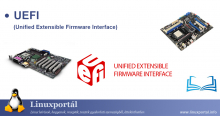Content
Overview
UEFI (Unified Extensible Firmware Interface) is a specification that defines the interface between the operating system and the platform firmware. UEFI will replace the former BIOS (Basic Input Output System) that was originally found on all IBM PC-compatible PCs, but most UEFI implementations that are still in use today also support legacy BIOS CSM (Compatibility Support Module) using. UEFI supports remote diagnostics and repair of computers, even without an operating system.
Intel developed the original Extensible Firmware Interface (EFI) specifications. Some of EFI’s practices and data formats reflect Microsoft Windows implementations and formats. In 2005, EFI 1.10 (the final edition of the EFI) became obsolete by UEFI. The Unified EFI Forum the body that manages UEFI regulations globally.
history
EFI's original motivation was the early development of the first Intel - HP Itanium systems in the mid-1990s. BIOS limitations (such as 16-bit processor mode, 1 MB of addressable space, and PC AT hardware) have become too restrictive for larger server platforms targeted by Itanium. Efforts to address these concerns began in 1998 and initially Intel Boot Initiativewas called. It was later renamed Extensible Firmware Interface (EFI).
In July 2005, Intel stopped developing the EFI specification for version 1.10 and contributed to the Unified EFI Forum, which revised the specification as the Unified Extensible Firmware Interface (UEFI). The original EFI specification is still owned by Intel, which licenses only EFI-based products, but the UEFI specification is owned by the UEFI Forum.
Version 2.1 of the UEFI standard was released on January 2007, 7. He added cryptography, network authentication and user interface architecture. UEFI version 2.8 was approved in March 2019.
Tiano was the first open source UEFI implementation released by Intel in 2004. Tiano has since been replaced by EDK and EDK2, and today is a TianoCore maintained by the community.
In December 2018, Microsoft announced a branch of the Mu project, TianoCore EDK2, which was launched by Microsoft Microsoft Surface and the Hyper-V used in products. The project supports the idea of Firmware as a service.
Advantages
The interface defined by the EFI specification includes data tables that contain platform information, as well as boot and run services that are available to both the operating system bootloader and the operating system. The UEFI firmware offers several technical advantages over the previous BIOS system:
- Can handle hard disks larger than 2 TB a GPT (GUID Partition Table) help
- The GPT partition table supports up to 128 primary partitions on a single disk
- Larger ESP (EFI System Partition) allows multiple operating system loaders to fit comfortably in the boot area
- It can initialize multiple hardware at the same time for faster hardware boot process
- CPU-independent architecture
- CPU-independent device controllers
- Flexible pre-operating environment for operating systems including cryptographic and networking capabilities.
- Modular design
- Backward and forward compatibility
- 484 views

